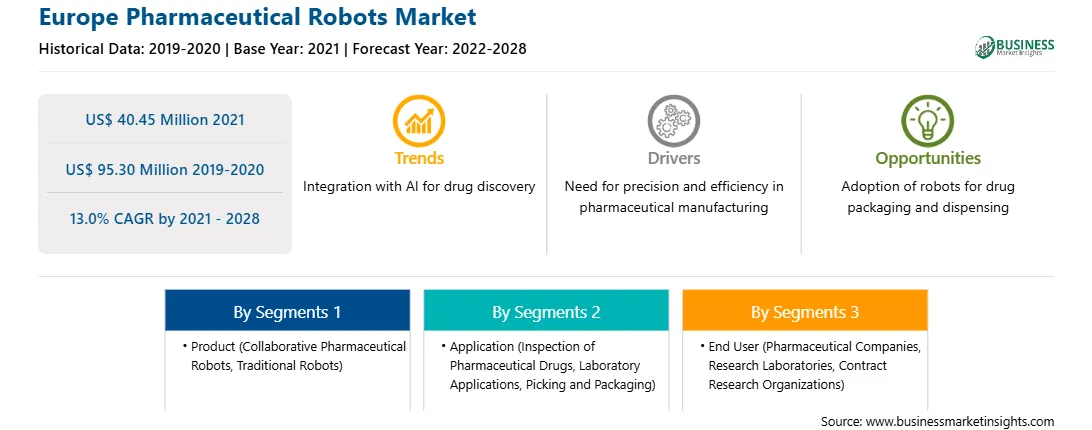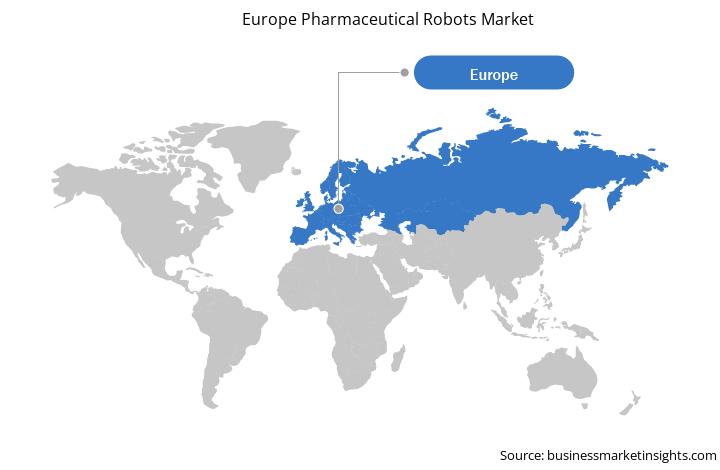The Europe pharmaceutical robots market is a highly fragmented market with the presence of considerable regional and local players providing numerous solutions for companies investing in the market arena. Cloud robotics is an emerging field of robotics rooted in cloud computing, cloud storage, and other Internet technologies centered on the benefits of converged infrastructure and shared services. Connecting robots to the cloud increase computational power, storage, and communications. Cloud robots communicate with each other and thus operations are carried out easily. The Google Cloud Robotics Platform combines AI, robotics, and the cloud to enable the opening of an ecosystem of automation solutions that use cloud-connected collaborative robots. Along with AI and machine learning services, the robots will be able to efficiently carry out processes in highly dynamic environments in the manufacturing industry. Moreover, in the industry, the cloud is an ally for processing a large amount of data. Cloud-based software, with appropriate security protocols, can be adopted to facilitate integration and automation. Its use helps reduce the paperwork of the companies, making data manageable. Thus, cloud robotics is expected to become the trend in the pharmaceutical robot market in the future.
As the coronavirus cases increase in the area, many countries are fighting to control the disease's spread. Artificial intelligence (AI) and machine learning represent a crucial part in better knowing and discussing the COVID-19 crisis. Machine learning technology permits computers to mimic human intelligence and ingest large volumes of data to identify patterns and insights quickly. In the fight toward COVID-19, associations have been instantaneous to utilize their machine learning expertise in several areas, such as scaling customer connections and knowing COVID-19 spreads and speeds up research and medication. The researchers recorded an elevated selection and use of AI in scientific and medical research, particularly in applications such as medical diagnosis, telemedicine, epidemiological studies, and clinical management of patients. There was also a shift in approaches towards AI and data distribution. According to the study, the crisis occurred in a comprehensive agreement of robots in the workplace and data distribution to monitor the virus's spread. In March 2020, Robotiq launched a pandemic initiative called Cobots vs. COVID. The program aims to help essential goods manufacturers such as medical equipment, pharmaceuticals, and others, rapidly increase their production by deploying cobot cells. Such initiatives in the region open a window of opportunities for the market players involved in the pharmaceutical robots market.

Strategic insights for the Europe Pharmaceutical Robots provides data-driven analysis of the industry landscape, including current trends, key players, and regional nuances. These insights offer actionable recommendations, enabling readers to differentiate themselves from competitors by identifying untapped segments or developing unique value propositions. Leveraging data analytics, these insights help industry players anticipate the market shifts, whether investors, manufacturers, or other stakeholders. A future-oriented perspective is essential, helping stakeholders anticipate market shifts and position themselves for long-term success in this dynamic region. Ultimately, effective strategic insights empower readers to make informed decisions that drive profitability and achieve their business objectives within the market.

| Report Attribute | Details |
|---|---|
| Market size in 2021 | US$ 40.45 Million |
| Market Size by 2028 | US$ 95.30 Million |
| Global CAGR (2021 - 2028) | 13.0% |
| Historical Data | 2019-2020 |
| Forecast period | 2022-2028 |
| Segments Covered |
By Product
|
| Regions and Countries Covered | Europe
|
| Market leaders and key company profiles |
The geographic scope of the Europe Pharmaceutical Robots refers to the specific areas in which a business operates and competes. Understanding local distinctions, such as diverse consumer preferences (e.g., demand for specific plug types or battery backup durations), varying economic conditions, and regulatory environments, is crucial for tailoring strategies to specific markets. Businesses can expand their reach by identifying underserved areas or adapting their offerings to meet local demands. A clear market focus allows for more effective resource allocation, targeted marketing campaigns, and better positioning against local competitors, ultimately driving growth in those targeted areas.

The pharmaceutical robots market in Europe is expected to grow from US$ 40.45 million in 2021 to US$ 95.30 million by 2028; it is estimated to grow at a CAGR of 13.0% from 2021 to 2028. In recent years, there have been considerable developments in the field of robotics. Robotics offers automation in various pharmaceutical manufacturing processes, such as filling, packaging, and inspection. A few benefits of automation in pharmaceutical manufacturing are improving efficiency in manufacturing, decreasing labor cost, reducing time used for training labors, protecting employees from a hazardous environment, and eliminating the chances of human errors and human contamination. Selective Compliance Assembly Robot Arm (SCARA) robots are used for common pick and place operations. Delta robots are also preferred for high-speed picking and packaging. Parallel robots are used for dispensing, kit assembly, sorting, and light machine tending applications. The pharmaceutical industry has realized the potential of robots for diverse applications in the manufacturing process. Merck employed a FANUC M-1iA delta robot on a bottling line, which places dispenser caps onto bottled allergy medications. FANUC M16iB is also used by laboratories for processing vials. Robots have the potential to handle 10 vials at a time, which increases the speed of production and thereby reduces manufacturing time. Pharmaceutical company benefits from robotic process automation (RPA) because it assists management in formulating strategies in real-time based on consumption trends and other regulatory changes. Thus, the use of robots in the pharmaceutical industry helps improve the overall product quality and speeds up the entire process of production, which enables the industry to meet the ever-growing demand for new drugs. Hence, the benefits offered by robots in the pharmaceutical industry drive the growth of the Europe pharmaceutical robots market.
Based on product, the traditional robots segment accounted for the largest share of the Europe pharmaceutical robots market in 2021. Based on application, the picking and packaging segment accounted for the largest share of the Europe pharmaceutical robots market in 2021. Based on end user, the pharmaceutical companies segment accounted for the largest share of the Europe pharmaceutical robots market in 2021.
A few major primary and secondary sources referred to for preparing this report on the Europe pharmaceutical robots market are company websites, annual reports, financial reports, national government documents, and statistical database, among others. Major companies listed in the report include ABB, Kawasaki Heavy Industries, Ltd., Yaskawa Electric Corporation, Universal Robots, Marchesini Group S.p.A, Denso Corporation, Fanuc Corporation, Seiko Epson Corporation and Weiss GmbH.
The Europe Pharmaceutical Robots Market is valued at US$ 40.45 Million in 2021, it is projected to reach US$ 95.30 Million by 2028.
As per our report Europe Pharmaceutical Robots Market, the market size is valued at US$ 40.45 Million in 2021, projecting it to reach US$ 95.30 Million by 2028. This translates to a CAGR of approximately 13.0% during the forecast period.
The Europe Pharmaceutical Robots Market report typically cover these key segments-
The historic period, base year, and forecast period can vary slightly depending on the specific market research report. However, for the Europe Pharmaceutical Robots Market report:
The Europe Pharmaceutical Robots Market is populated by several key players, each contributing to its growth and innovation. Some of the major players include:
The Europe Pharmaceutical Robots Market report is valuable for diverse stakeholders, including:
Essentially, anyone involved in or considering involvement in the Europe Pharmaceutical Robots Market value chain can benefit from the information contained in a comprehensive market report.